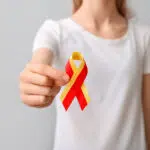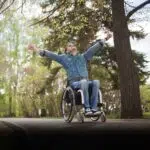Paddle for Perthes Disease Awareness Day is observed on the last Saturday in July every year. This year, it falls on July 26. Perthes disease, fully known as Legg–Calvé–Perthes disease (L.C.P.D.), is a childhood hip disorder caused by a disruption of blood flow to the hip bone. Without sufficient blood, the bones break easily and do not heal properly. To celebrate today, an annual paddling event is held, as a paddle doesn’t involve the use of legs, so people who are affected by this disease can participate and raise awareness.
History of Paddle for Perthes Disease Awareness Day
Perthes disease is one of the most common hip disorders in young children, occurring in roughly 5.5 of 100,000 children per year. The lifetime risk of a child developing the disease is about one per 1,200 individuals. Boys are affected about three to five times more often than girls.
New cases of Perthes’ disease rarely occur after the age of 14 years. White northern Europeans appear to be affected more frequently than other ethnicities, though a paucity of reliable epidemiology exists in the Southern Hemisphere.
In 1897, Karel Maydl first described the disease and in 1909 personal research was carried out by Henning Waldenström and he identified the disease, attributing it to tuberculosis. However, in 1910, the disease was recognized as being unrelated to tuberculosis by three physicians working independently. Legg–Calvé–Perthes is named after these three doctors: Arthur Legg, Jacques Calvé, and Georg Perthes.
The first and original event Paddle for Perthes Disease Awareness Day was posted via Twitter and Facebook in 2010. Despite no events being organized, the occasion was still remembered.
In the U.K. in 2016, a nationwide study began collecting details of every case of Perthes’ disease as part of the British Orthopedic Surgery Surveillance Study. This aims to get core information about the disease, before starting extensive clinical trials about the best forms of treatment.
Every hospital in England, Scotland, and Wales which treats Perthes’ disease is collecting details of new cases. The study is nationally approved by the U.K. ethics committee and N.H.S. research approval teams in England, Scotland, and Wales. The study is funded by the National Institute for Health Research and the Alder Hey Charity.
Paddle for Perthes Disease Awareness Day timeline
A physician named Karel Maydl working on one of the cases identifies Perthes' disease.
A physician named Henning Waldenström likens the disease to tuberculosis.
Three physicians, namely Arthur Legg, Jacques Calvé, and Georg Perthes, working independently, identify that the disease is unrelated to tuberculosis.
The first Paddle for Perthes Disease Awareness Day event is celebrated.
Paddle for Perthes Disease Awareness Day FAQs
Is Perthes Disease permanent?
No, most children with Perthes’ disease eventually recover, but it can take from two to five years for the femoral head to regrow and return to normal, or close to normal.
What are the stages of Perthes disease?
The Perthes stages include the onset stage; fragmentation stage; reconstitution stage; residual stage. Each stage of Perthes disease has key indicators, which signifies the progression of the disease through the various stages.
What happens if Perthes Disease is not treated?
If left untreated, the femoral head can deform and not fit well within the acetabulum.
How to Observe Paddle for Perthes Disease Awareness Day
Join a Perthes Disease fundraising event
Join a Perthes Disease Fundraising group to raise money to support people affected by the disease. Only speaking about Perthes will not generate the level of support needed to care for people living with the disease. Every money you raise will go a long way in funding therapies, physical and mental health support, training, and research.
Help create awareness about Perthes Disease
You can change the attitude of the public towards people suffering from Perthes by creating awareness. Sharing useful information about Perthes on podcasts, social media, and news publications is a great way to sensitize the general public and draw their attention to the existence of Perthes.
Visit Patients Suffering from Perthes Disease
Show compassion and care for the sick by visiting them in the hospital. A visit can go a long way in making the patient happy, and improving their health. Sometimes, what they need is just someone to talk to and who understands how they feel.
5 Facts About Perthes Disease
One in every 1,200 people has it
Perthes' Disease affects children between the ages of three and 11 years in one person out of every 1,200 people.
Most children recover from Perthes Disease
Most children recover from Perthes disease, but it can take two or more years for the bone to regrow and return to normal.
Children with Perthes Disease avoid high-impact activities
Children with Perthes Disease are advised to avoid high-impact activities, like running and jumping until the hip joint heals completely.
It isn’t caused by genetic factors
The cause of Legg-Calvé-Perthes Disease is yet unknown.
Perthes Disease can also occur in adults
Although the disease is common in children, adults are also affected in some cases.
Why Paddle for Perthes Disease Awareness Day is Important
It’s an opportunity to create awareness of Perthes Disease
Paddle For Perthes Disease Awareness day is a once-in-a-year opportunity to join others in raising awareness about Perthes disease. Since Perthes can be treated, it’s an occasion to raise the much-needed funds to support people living with the disease.
It can change the attitude of the public towards Perthes Disease
We get to join virtual and real-life campaigns working towards making the public sensitive to the suffering of people living with Perthes. We are also able to help patients and their relatives reach more people affected by the condition.
It motivates and provides funds for Perthes Disease treatment and research
By taking part in fundraising events, we draw the attention of the public toward Perthes Disease and raise funds for the research and treatment of the condition. During these events, we also collect and distribute information on Perthes Disease.
Paddle for Perthes Disease Awareness Day dates
| Year | Date | Day |
|---|---|---|
| 2024 | July 27 | Saturday |
| 2025 | July 26 | Saturday |
| 2026 | July 25 | Saturday |




















